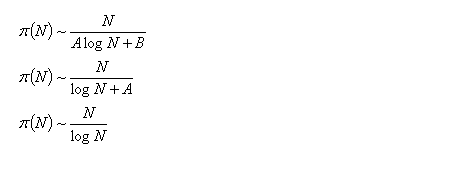Godfrey Harold Hardy (1877-1947) remarked that Skewe’s number is ‘the largest number that has ever served any definite purpose in mathematics’. [1]
The story starts when we consider the prime numbers- numbers that do not divide wholly with any number except for one and itself. The first few prime numbers are
2, 3, 5, 7, 11, 13, 17, 19...
In 300BC, Euclid of Alexandria proved that there are infinitely many prime numbers. [2]
The prime counting function π(N) now comes into play. π(N) simply counts the number of prime numbers equal or less than N.
For N = 11, π(11) = 5. There are 5 prime numbers equal or less than N: 2, 3, 5, 7 & 11.
π(0) = 0
π(1) = 0
π(2) = 1
π(3) = 2
π(4) = 2
π(5) = 3
π(6) = 3
π(100,000,000) = 5761455 [2]
Because the exact distribution of primes is not predictable, number theorists have had to make do with functions that would approximate π(N).
Over the years, various proposals have been made to estimate π(N) at large values of N, each conjecture more accurate than the last.

The twiddle sign (~) indicates that the approximation gets increasingly accurate for larger values of N.
Bernhard Reimann’s landmark 1859 doctorate paper refines the prime counting function’s estimate to a very precise but unproven estimate [2]

Where li(N) is the (natural) log integral from 0 to N.
From here, we will go on to explain how Skewe’s number came about.
Riemann’s log integral was a a good approximation of the prime counting function π(N). However, li(N) seemed to consistently overestimating the actual value of π(N).
For example, at large values of t, 0 can be closely approximated by the following exponential function:

In this particular example, the exponential function is always positive (for positive t), hence consistently overestimating the value of zero. However, the function approaches 0 for increasing t.
The appeared to be the case with Riemann’s log integral- it was consistently larger than π(N), but the error shrinks with larger values of N. For all N within our grasp, li(N) was greater than π(N). In fact, Gauss (1777-1855) was thought to believe that li(N) would always overestimate π(N). [2]
In 1914, John Edensor Littlewood proved that on the contrary, li(N) can overestimate and underestimate π(N), and switches back and forth infinitely many times. This result created quite a sensation, and the next question was obviously, at what value of N is the first ‘Littlewood violation’ (where li(N) turns from overestimation to underestimation)?
In 1933, one of Littlewood’s students Samuel Skewes showed that assuming the truth of the Riemann Hypothesis, the first Littlewood violation would be definitely less than the following number, now known as (the first) Skewe’s number [2] [3]:

GH Hardy calculated that if one were to play chess using every particle in the universe (10^84 particles), where one step is the exchange of two particles, then the number of possible games is roughly equal to Skewe’s number. [1]
In 2000, the upper bound of the first Littlewood violation was estimated to be near the vicinity of 1.39822 x 10^316, a mere 316 digit number. Another paper shows that there is a small possibility of the first violation occurring around 10^176. [2]
However, this is not the end of the story. Samuel Skewes also showed that assuming the Riemann Hypothesis is false (as opposed to the previous true assumption), the first Littlewood violation would occur below another even more monstrous number, known as the second Skewe’s number: [3]
 References:
References:[1] Simon Singh, ‘Fermat’s Last Theorem’, Fourth Estate, London 1997.
[2] John Derbyshire, ‘Prime Obsession – Bernhard Riemann and the greatest unsolved problem in mathematics’, Joseph Henry Press, Washington DC, 2003.
[3] Eric W. Weisstein, ‘
Skewes Number’, MathWorld
MathematicsLabels: mathematics, number theory



















































